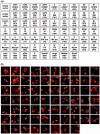ViralORFeome: an integrated database to generate a versatile collection of viral ORFs
- PMID: 20007148
- PMCID: PMC2808970
- DOI: 10.1093/nar/gkp1000
ViralORFeome: an integrated database to generate a versatile collection of viral ORFs
Abstract
Large collections of protein-encoding open reading frames (ORFs) established in a versatile recombination-based cloning system have been instrumental to study protein functions in high-throughput assays. Such 'ORFeome' resources have been developed for several organisms but in virology, plasmid collections covering a significant fraction of the virosphere are still needed. In this perspective, we present ViralORFeome 1.0 (http://www.viralorfeome.com), an open-access database and management system that provides an integrated set of bioinformatic tools to clone viral ORFs in the Gateway(R) system. ViralORFeome provides a convenient interface to navigate through virus genome sequences, to design ORF-specific cloning primers, to validate the sequence of generated constructs and to browse established collections of virus ORFs. Most importantly, ViralORFeome has been designed to manage all possible variants or mutants of a given ORF so that the cloning procedure can be applied to any emerging virus strain. A subset of plasmid constructs generated with ViralORFeome platform has been tested with success for heterologous protein expression in different expression systems at proteome scale. ViralORFeome should provide our community with a framework to establish a large collection of virus ORF clones, an instrumental resource to determine functions, activities and binding partners of viral proteins.
Figures




Similar articles
-
The full-ORF clone resource of the German cDNA Consortium.BMC Genomics. 2007 Oct 31;8:399. doi: 10.1186/1471-2164-8-399. BMC Genomics. 2007. PMID: 17974005 Free PMC article.
-
New tools at the Candida Genome Database: biochemical pathways and full-text literature search.Nucleic Acids Res. 2010 Jan;38(Database issue):D428-32. doi: 10.1093/nar/gkp836. Epub 2009 Oct 6. Nucleic Acids Res. 2010. PMID: 19808938 Free PMC article.
-
CyanoBase: the cyanobacteria genome database update 2010.Nucleic Acids Res. 2010 Jan;38(Database issue):D379-81. doi: 10.1093/nar/gkp915. Epub 2009 Oct 30. Nucleic Acids Res. 2010. PMID: 19880388 Free PMC article.
-
The integrated microbial genomes system: an expanding comparative analysis resource.Nucleic Acids Res. 2010 Jan;38(Database issue):D382-90. doi: 10.1093/nar/gkp887. Epub 2009 Oct 28. Nucleic Acids Res. 2010. PMID: 19864254 Free PMC article.
-
ORFer--retrieval of protein sequences and open reading frames from GenBank and storage into relational databases or text files.BMC Bioinformatics. 2002 Dec 19;3:40. doi: 10.1186/1471-2105-3-40. Epub 2002 Dec 19. BMC Bioinformatics. 2002. PMID: 12493080 Free PMC article.
Cited by
-
Exploration of panviral proteome: high-throughput cloning and functional implications in virus-host interactions.Theranostics. 2014 Jun 6;4(8):808-22. doi: 10.7150/thno.8255. eCollection 2014. Theranostics. 2014. PMID: 24955142 Free PMC article.
-
Flavivirus NS3 and NS5 proteins interaction network: a high-throughput yeast two-hybrid screen.BMC Microbiol. 2011 Oct 20;11:234. doi: 10.1186/1471-2180-11-234. BMC Microbiol. 2011. PMID: 22014111 Free PMC article.
-
Mapping of Chikungunya virus interactions with host proteins identified nsP2 as a highly connected viral component.J Virol. 2012 Mar;86(6):3121-34. doi: 10.1128/JVI.06390-11. Epub 2012 Jan 18. J Virol. 2012. PMID: 22258240 Free PMC article.
-
Adaptive Evolution Signatures in Prochlorococcus: Open Reading Frame (ORF)eome Resources and Insights from Comparative Genomics.Microorganisms. 2024 Aug 20;12(8):1720. doi: 10.3390/microorganisms12081720. Microorganisms. 2024. PMID: 39203562 Free PMC article.
-
Advances in bioinformatics and multi-omics integration: transforming viral infectious disease research in veterinary medicine.Virol J. 2025 Jan 31;22(1):22. doi: 10.1186/s12985-025-02640-x. Virol J. 2025. PMID: 39891257 Free PMC article. Review.
References
-
- Brasch MA, Hartley JL, Vidal M. ORFeome cloning and systems biology: standardized mass production of the parts from the parts-list. Genome Res. 2004;14:2001–2009. - PubMed
-
- Uetz P, Rajagopala SV, Dong YA, Haas J. From ORFeomes to protein interaction maps in viruses. Genome Res. 2004;14:2029–2033. - PubMed
-
- Reboul J, Vaglio P, Rual JF, Lamesch P, Martinez M, Armstrong CM, Li S, Jacotot L, Bertin N, Janky R, et al. C. elegans ORFeome version 1.1: experimental verification of the genome annotation and resource for proteome-scale protein expression. Nat. Genet. 2003;34:35–41. - PubMed
Publication types
MeSH terms
LinkOut - more resources
Full Text Sources
Other Literature Sources

